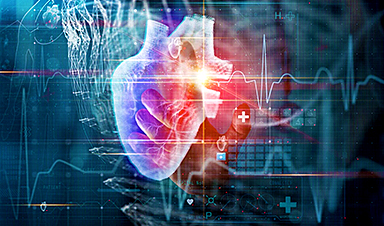AI can now predict deadly heart arrhythmias up to two weeks in advance, potentially transforming cardiac care.
Artificial intelligence could play a key role in preventing many cases of sudden cardiac death, according to a new study published in the European Heart Journal. Researchers from Inserm, Paris Cité University, and the Paris public hospital group (AP-HP), in collaboration with colleagues in the United States, have developed an artificial neural network modeled after the human brain.
By analyzing data from over 240,000 ambulatory electrocardiograms (ECGs), the AI algorithm was able to identify patients at high risk of experiencing a life-threatening arrhythmia capable of triggering cardiac arrest within two weeks—with an accuracy exceeding 70%.
Sudden cardiac death claims more than 5 million lives globally each year. Often, these fatal events occur without warning, affecting individuals with no prior diagnosis of heart disease.
This study highlights the potential of AI to significantly improve the early detection of dangerous arrhythmias, abnormal heart rhythms that can lead to sudden cardiac arrest, by identifying at-risk patients before symptoms appear.
Developing an AI That Mimics the Brain
As part of this study, a network of artificial neurons was developed by a team of engineers from the company Cardiologs (Philips group) in collaboration with the universities of Paris Cité and Harvard. What this algorithm does is imitate the functions of the human brain in order to improve the prevention of cardiac sudden death.
The researchers analyzed several million hours of heartbeats thanks to data from 240,000 ambulatory electrocardiograms collected in six countries (USA, France, UK, South Africa, India, and Czechia).
Thanks to artificial intelligence, the researchers were able to identify new weak signals that herald the risk of arrhythmia. They were particularly interested in the time needed to electrically stimulate and relax the heart ventricles during a complete cycle of cardiac contraction and relaxation.
New Predictive Signals Identified
“By analyzing their electrical signal for 24 hours, we realized that we could identify the subjects susceptible of developing a serious heart arrhythmia within the next two weeks. If left untreated, this type of arrhythmia can progress towards a fatal cardiac arrest,” explains Dr. Laurent Fiorina, first author of the study, researcher at the Paris Cardiovascular Research Centre (PARCC) (Inserm/Paris Cité University),” cardiologist at Cardiovascular Institute Paris-Sud (ICPS) (Ramsay, Massy), and medical director in charge of artificial intelligence at Philips.
While the artificial neural network is still in the evaluation phase, it showed itself in this study to be capable of detecting at-risk patients in 70% of cases, and no-risk patients in 99.9% of cases.
In the future, this algorithm could be used to monitor at-risk patients in hospitals. If its performance is refined, it could also be used in devices such as ambulatory Holters that measure blood pressure to reveal hypertension risks. It could even be used in smartwatches.
A Paradigm Shift in Cardiac Risk Prediction
“What we’re proposing here is a paradigm change in the prevention of sudden death, “comments Eloi Marijon, Inserm research director at PARCC (Inserm/Paris Cité University), professor of cardiology at Paris Cité University and head of the cardiology department at Georges Pompidou European Hospital AP-HP.
“Until now we’d been trying to identify patients at risk over the medium and long term, but were incapable of predicting what could happen in the minutes, hours, or days that precede a cardiac arrest. Now, thanks to artificial intelligence, we can predict these events in the very short term and potentially take action before it’s too late.”
The researchers now wish to conduct prospective clinical studies to test the efficacy of this model under real-world conditions.
“It’s essential for this technology to be evaluated in clinical trials before being used in medical practice,” insists Dr. Fiorina. “But what we’ve already shown is that AI has the potential to radically transform the prevention of serious arrhythmias.”
Reference: “Near-term prediction of sustained ventricular arrhythmias applying artificial intelligence to single-lead ambulatory electrocardiogram” by Laurent Fiorina, Tanner Carbonati, Kumar Narayanan, Jia Li, Christine Henry, Jagmeet P Singh and Eloi Marijon, 30 March 2025, European Heart Journal.
DOI: 10.1093/eurheartj/ehaf073
News
Scientists discover cancer-fighting bacteria that ‘soak up’ forever chemicals in the body
A family of healthy bacteria may help 'soak up' toxic forever chemicals in the body, warding off their cancerous effects. Forever chemicals, also known as PFAS (per- and polyfluoroalkyl substances), are toxic chemicals that [...]
Johns Hopkins Researchers Uncover a New Way To Kill Cancer Cells
A new study reveals that blocking ribosomal RNA production rewires cancer cell behavior and could help treat genetically unstable tumors. Researchers at the Johns Hopkins Kimmel Cancer Center and the Department of Radiation Oncology and Molecular [...]
AI matches doctors in mapping lung tumors for radiation therapy
In radiation therapy, precision can save lives. Oncologists must carefully map the size and location of a tumor before delivering high-dose radiation to destroy cancer cells while sparing healthy tissue. But this process, called [...]
Scientists Finally “See” Key Protein That Controls Inflammation
Researchers used advanced microscopy to uncover important protein structures. For the first time, two important protein structures in the human body are being visualized, thanks in part to cutting-edge technology at the University of [...]
AI tool detects 9 types of dementia from a single brain scan
Mayo Clinic researchers have developed a new artificial intelligence (AI) tool that helps clinicians identify brain activity patterns linked to nine types of dementia, including Alzheimer's disease, using a single, widely available scan—a transformative [...]
Is plastic packaging putting more than just food on your plate?
New research reveals that common food packaging and utensils can shed microscopic plastics into our food, prompting urgent calls for stricter testing and updated regulations to protect public health. Beyond microplastics: The analysis intentionally [...]
Aging Spreads Through the Bloodstream
Summary: New research reveals that aging isn’t just a local cellular process—it can spread throughout the body via the bloodstream. A redox-sensitive protein called ReHMGB1, secreted by senescent cells, was found to trigger aging features [...]
AI and nanomedicine find rare biomarkers for prostrate cancer and atherosclerosis
Imagine a stadium packed with 75,000 fans, all wearing green and white jerseys—except one person in a solid green shirt. Finding that person would be tough. That's how hard it is for scientists to [...]
Are Pesticides Breeding the Next Pandemic? Experts Warn of Fungal Superbugs
Fungicides used in agriculture have been linked to an increase in resistance to antifungal drugs in both humans and animals. Fungal infections are on the rise, and two UC Davis infectious disease experts, Dr. George Thompson [...]
Scientists Crack the 500-Million-Year-Old Code That Controls Your Immune System
A collaborative team from Penn Medicine and Penn Engineering has uncovered the mathematical principles behind a 500-million-year-old protein network that determines whether foreign materials are recognized as friend or foe. How does your body [...]
Team discovers how tiny parts of cells stay organized, new insights for blocking cancer growth
A team of international researchers led by scientists at City of Hope provides the most thorough account yet of an elusive target for cancer treatment. Published in Science Advances, the study suggests a complex signaling [...]
Nanomaterials in Ophthalmology: A Review
Eye diseases are becoming more common. In 2020, over 250 million people had mild vision problems, and 295 million experienced moderate to severe ocular conditions. In response, researchers are turning to nanotechnology and nanomaterials—tools that are transforming [...]
Natural Plant Extract Removes up to 90% of Microplastics From Water
Researchers found that natural polymers derived from okra and fenugreek are highly effective at removing microplastics from water. The same sticky substances that make okra slimy and give fenugreek its gel-like texture could help [...]
Instant coffee may damage your eyes, genetic study finds
A new genetic study shows that just one extra cup of instant coffee a day could significantly increase your risk of developing dry AMD, shedding fresh light on how our daily beverage choices may [...]
Nanoneedle patch offers painless alternative to traditional cancer biopsies
A patch containing tens of millions of microscopic nanoneedles could soon replace traditional biopsies, scientists have found. The patch offers a painless and less invasive alternative for millions of patients worldwide who undergo biopsies [...]
Small antibodies provide broad protection against SARS coronaviruses
Scientists have discovered a unique class of small antibodies that are strongly protective against a wide range of SARS coronaviruses, including SARS-CoV-1 and numerous early and recent SARS-CoV-2 variants. The unique antibodies target an [...]





















